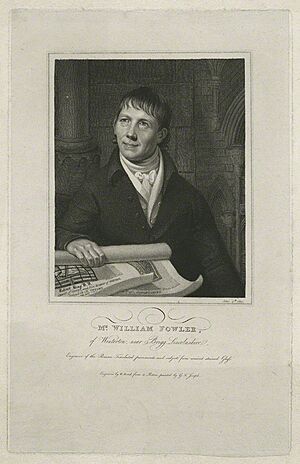William Fowler (artist) facts for kids
William Fowler (born March 12, 1761 – died September 22, 1832) was a talented English artist. He was born in a town called Winterton, Lincolnshire. His father, Joseph Fowler, worked as a builder.
William Fowler first became an architect and builder in Winterton. Around 1796, he drew pictures of ancient Roman floor designs, called pavements, that were found there. He took these drawings to London to have them engraved. While in London, he learned how to do copper-plate engraving. This is a way of making prints from designs carved into copper plates.
In 1799, William Fowler released his first colored engraving of a Roman pavement found in Roxby. Over the next 30 years, until 1829, he published three books filled with his colored engravings. These books included pictures of Roman pavements, stained-glass windows, old metal plaques (brasses), stone slabs, and other interesting historical items. He also made many engravings that were never published.
William Fowler became friends with famous people like Sir Walter Scott. He even met the royal family at Windsor Castle. Today, you can see some of his amazing artwork at the North Lincolnshire Museum in Scunthorpe and the Baysgarth House Museum in Barton-upon-Humber.
Contents
Why William Fowler's Art Was Special
A famous person named Sir Joseph Banks once said about Fowler's work: "Others have shown us what they thought these remains ought to have been, but Fowler has shown us what they are, and that is what we want." This means that William Fowler was very good at showing things exactly as they were. He was known for being extremely accurate, which was quite rare for artists at that time.
He often worked from direct copies or rubbings of the original items. People say he was the first artist to show the lead lines in pictures of stained-glass windows. These are the lines that hold the pieces of colored glass together. A well-known portrait of him was made in 1810 by W. Bond, based on a painting by George Francis Joseph.
Buildings William Fowler Designed
Most of what we know about William Fowler's building and repair work comes from a book published by his grandson in 1907.
Churches He Repaired
William Fowler helped repair and update several churches:
- Manton, Lincolnshire (1809)
- Appleby (1820-1823)
- Winteringham (1827)
- Adlingfleet, Yorkshire
Houses He Built or Changed
Fowler also worked on many houses:
- Cleatham Hall Coach House (1802)
- Leadenham Rectory, Lincolnshire (1821–1823)
- The Rectory in Caythorpe, Lincolnshire (around 1827)
- Gate Burton Hall (1824–1827)
- Messingham Vicarage, Lincolnshire (1813–1818)
- Roxby Low Rise Farmhouse
- Subdeanery, Minster Yard, Lincoln (around 1813)
- Appleby Hall, Lincolnshire (1821-1823) – This building is no longer standing.
- Winterton *The Chains* or “Gothic Cottage” (1827–1828) – Fowler built this house for himself. It has a unique design with parts of the upper floors sticking out.
- Appleby Spring Wood House (1823) – This house looks like a castle with towers. It has a special octagonal (eight-sided) room inside. It is considered an important historical building.
Other Buildings He Worked On
- Newark National School, Nottinghamshire (now the Mount School)
- Newark Subscription Library and Reading Room
Images for kids



